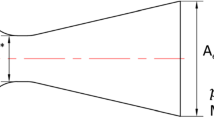Abstract:
Lighthill's theory of aerodynamic sound provides an effective way of investigating underwater flow noise. When combined with a model of the coherent vortical structures in a turbulent boundary layer, it predicts the wave-number frequency pressure spectrum on a rigid surface and, in particular, highlights the rôle of surface viscous stresses as a source of low wave-number pressure fluctuations on a plane surface. The inclusion of surface curvature and flexibility enables the theory to be applied to acoustic streamers (sometimes known as towed arrays). The effect of the interior mechanical structure of the streamers on the flow noise is investigated. Simple algebraic forms are derived for the comparative performance of liquid and visco-elastic-filled streamers. The introduction of porous foam into a liquid streamer is found to be a particularly effective way of attenuating low wave-number disturbances, and theoretical predictions are compared with experiment.
Similar content being viewed by others
Author information
Authors and Affiliations
Additional information
Received 19 December 1996 and accepted 2 May 1997
Rights and permissions
About this article
Cite this article
Dowling, A. Underwater Flow Noise . Theoret. Comput. Fluid Dynamics 10, 135–153 (1998). https://doi.org/10.1007/s001620050055
Issue Date:
DOI: https://doi.org/10.1007/s001620050055




